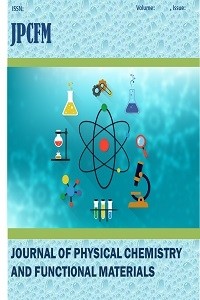Exploring Electronic and Structural Properties of Titanium-Doped Chlorapatite: A Theoretical and Experimental Investigation
Exploring Electronic and Structural Properties of Titanium-Doped Chlorapatite: A Theoretical and Experimental Investigation
Chlorapatite, Ti-doping, Density functional theory (DFT), Bandgap,
___
- A. Durugkar, S. Tamboli, N.S. Dhoble, S.J. Dhoble, “Novel photoluminescence properties of Eu3+ doped chlorapatite phosphor synthesized via sol-gel method” Materials Research Bulletin, 97, 466-472, 2018. https://doi.org/10.1016/j.materresbull.2017.09.043.
- H. Jena, B.K. Maji, R. Asuvathraman, K.V.G. Kutty, “Synthesis and thermal characterization of glass bonded Ca-chlorapatite matrices for pyrochemical chloride waste immobilization” Journal of Non-Crystalline Solids, 358, 1681-1686, 2012. https://doi.org/10.1016/j.jnoncrysol.2012.05.002.
- H. Jena, B.K. Maji, R. Asuvathraman, K.V.G. Kutty, “Effect of pyrochemical chloride waste loading on thermo-physical properties of borosilicate glass bonded Sr-chlorapatite composites” Materials Chemistry and Physics, 162, 188-196, 2015. http://dx.doi.org/10.1016/j.matchemphys.2015.05.057.
- N.J. Flora, K.W. Hamilton, R.W. Schaeffer, C.H. Yoder, “A Comparative Study of the Synthesis of Calcium, Strontium, Barium, Cadmium, and Lead Apatites in Aqueous Solution” Synthesis and Reactivity in Inorganic and Metal-Organic Chemistry, 34(3), 503-521, 2004. https://doi.org/10.1081/SIM-120030437.
- B.K. Maji, H. Jena, R.V. Krishnan, R. Asuvathraman, K. Ananthasivan, K.V.G. Kutty, “Comparison of thermal expansion and heat capacity properties of various borosilicate glass-bonded strontium chlorapatite composites loaded with simulated pyrochemical waste” Journal of Thermal Analysis and Calorimetry, 119, 1825-1831, 2015. https://doi.org/10.1007/s10973-014-4322-1.
- H. Jena, R.V. Krishnan, R. Asuvathraman, K. Nagarajan, K.V.G. Kutty, “Thermal expansion and heat capacity measurements on Ba10−x Cs x (PO4)6Cl2−δ, (x=0, 0.5) chlorapatites synthesized by sonochemical process” Journal of Thermal Analysis and Calorimetry, 106, 875-879, 2011. https://doi.org/10.1007/s10973-011-1715-2.
- M.H. Hwang, Y.J. Kim, S.H. Jung, S.H. Han, “Preparation and Luminescent Characterization of M5(PO4)3Cl (M: Sr, Ca) Chlorapatites by a Solid-state Reaction Method” Synthesis and Reactivity in Inorganic and Metal-Organic Chemistry, 38(3), 307-311, 2008. https://www.tandfonline.com/doi/full/10.1080/15533170802023528.
- M. Ganjali, S. Pourhashem, M. Mozafari, “The effect of heat-treatment on the structural characteristics of nanocrystalline chlorapatite particles synthesized via an in situ wet-chemical route” Ceramics International, 41(10), 13100-13104, 2015, https://doi.org/10.1016/j.ceramint.2015.07.020.
- X. Xu, X. Yu, L. Mao, S.P. Yang, Z. Peng, “Preparation and photoluminescence of Bi3+-doped strontium chlorapatite nano-phosphor” Materials Letters, 58(29), 3665-3668, 2004, https://doi.org/10.1016/j.matlet.2004.04.037.
- M. Nabiyouni, H. Zhou, S.B. Bhaduri, “Microwave assisted solution combustion synthesis (MASCS) of europium (Eu) doped chlorapatite nanowhiskers” Materials Letters, 108, 54-57, 2013, https://doi.org/10.1016/j.matlet.2013.06.089.
- R. Pazik, J.M. Nedelec, R.J. Wiglusz, “Preferential site substitution of Eu3+ ions in Ca10(PO4)6Cl2 nanoparticles obtained using a microwave stimulated wet chemistry technique” CrystEngComm, 16, 5308-5318, 2014, https://doi.org/10.1039/C4CE00197D.
- C.H. Wang, D.Y. Gui, R. Qin, F.L. Yang, X.P. Jing, G.S. Tian, W. Zhu, “Site and local structure of activator Eu2+ in phosphor Ca10−x(PO4)6Cl2:xEu2+” Journal of Solid State Chemistry, 206, 69-74, 2013, https://doi.org/10.1016/j.jssc.2013.07.035.
- B. Nasiri-Tabrizi, W.J. Basirun, B. Pingguan-Murphy, “Mechanochemical preparation and structural characterization of Ta-doped chlorapatite nanopowders” Progress in Natural Science, 26(6), 546-554, 2016, https://doi.org/10.1016/j.pnsc.2016.11.010.
- B. Nasiri-Tabrizi, E. Zalnezhad, B. Pingguan-Murphy, W.J. Basirun, A.M.S. Hamouda, S. Baradaran, “Structural and morphological study of mechanochemically synthesized crystalline nanoneedles of Zr-doped carbonated chlorapatite” Materials Letters, 149, 100-104, 2015, https://doi.org/10.1016/j.matlet.2015.02.125.
- L. Wang, K. Liu, J. Wang, L. Zhao, Y. Xu, R. Zhou, L. Chen, B. Qu, “Defects levels and VUV/UV luminescence of Ce3+ and Eu3+ doped chlorapatite phosphors M5(PO4)3Cl (M = Ca, Sr, Ba)” Optical Materials, 107, 110014, 2020, https://doi.org/10.1016/j.optmat.2020.110014.
- Z. Zhang, J. Wang, M. Zhang, Q. Zhang, Q. Su, “The energy transfer from Eu2+ to Tb3+ in calcium chlorapatite phosphor and its potential application in LEDs” Applied Physics B, 91, 529-537, 2008, https://doi.org/10.1007/s00340-008-3035-1.
- Y.K. Kim, M. Lee, H.S. Yang, M.G. Ha, K.S. Hong, “Optical characteristics of the rare-earth-ions-doped calcium chlorapatite phosphors prepared by using the solid–state reaction method” Current Applied Physics, 16(3), 357-360, 2016, https://doi.org/10.1016/j.cap.2015.12.016.
- A. Fahami, G.W. Beall, “Mechanosynthesis of carbonate doped chlorapatite–ZnO nanocomposite with negative zeta potential” Ceramics International, 41(9), 12323-12330, 2015, https://doi.org/10.1016/j.ceramint.2015.06.061.
- S.J. Clark, M.D. Segall, C.J. Pickard, P.J. Hasnip, M.I.J. Probert, K. Refson, M.C. Payne, “First Principles Methods Using CASTEP” Zeitschrift für Kristallographie-Crystalline Materials, 220, 567-570, 2005, https://doi.org/10.1524/zkri.220.5.567.65075.
- K. Momma, F. Izumi, “VESTA 3 for three-dimensional visualization of crystal, volumetric and morphology data” Journal of Applied Crystallography, 44, 1272-1276, 2011, http://dx.doi.org/10.1107/S0021889811038970.
- C.C. Ribeiro, I. Gibson, M.A. Barbosa, “The uptake of titanium ions by hydroxyapatite particles-structural changes and possible mechanisms” Biomaterials, 27(9), 1749-1761, 2006, https://doi.org/10.1016/j.biomaterials.2005.09.043.
- B.D. Cullity, “Elements of X-ray diffraction” Addison-Wesley Publishing Company, Massachusetts, 1978
- M.E. Fleet, X. Liu, “Type A–B carbonate chlorapatite synthesized at high pressure” Journal of Solid State Chemistry, 181(9), 2494-2500, 2008, https://doi.org/10.1016/j.jssc.2008.06.016.
- L.D.A. Cavalcante, L.S. Ribeiro, M.L. Takeno, P.T.P. Aum, Y.K.P.G. Aum, J.C.S. Andrade, “Chlorapatite derived from fish scales” Materials, 13(5), 1129, 2020, https://doi.org/10.3390/ma13051129.
- A. Fahami, G.W. Beall, T. Betancourt, “Synthesis, bioactivity and zeta potential investigations of chlorine and fluorine substituted hydroxyapatite” Materials Science and Engineering: C, 59, 78-85, 2016, https://doi.org/10.1016/j.msec.2015.10.002.
- ISSN: 2651-3080
- Yayın Aralığı: Yılda 2 Sayı
- Başlangıç: 2018
- Yayıncı: Niyazi BULUT
Hanifi KEBİROGLU, Mücahit YILMAZ
Serhat KESER, Tankut ATEŞ, Niyazi BULUT, Omer KAYGILI
Quantum Chemical and Biological Properties of Coumarin Derivative Compound
Serhat KESER, Tankut ATEŞ, Niyazi BULUT, Omer KAYGILI
Spectroscopic and Photonic Properties of Dexamethasone used in the Treatment of COVID-19 Patients
Abdullahi MUHAMMAD, Kamaludeen SULAİMAN KABO, Auwal YUSHAU
A Review on Measurement of Radon Gas Concentration in Drinking Water
